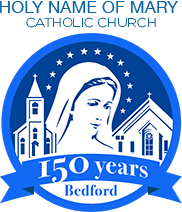Easter Sunday
April 20, 2014 – Year A
Readings: Acts 10:34A, 37-43, Psalm 118, Col 3:1-4, Jn 20:1-9
by Rev. Mr. Ray Roderique, Permanent Deacon
Each of the eye witnesses in the New Testament gives differing accounts of Christ’s resurrection. Here is the Apostle John’s account: Early on the first day of the week, while it was still dark, Mary Magdalene went to the tomb and saw that the stone had been removed from its entrance. So she came running to Simon Peter and another disciple, who seems to be the Apostle John, and said, “They have taken the Lord out of the tomb and we don’t know where they have put him!” So Peter and John started for the tomb. Both were running, but John outran Peter and reached the tomb first. He bent over and looked in at the strips of linen lying there but did not go in. Then Peter came along behind him and, true to his impulsive character, went straight through the open door into the tomb. He saw the strips of linen and the cloth that had once covered Jesus’ dead body, but the body was gone. The tomb was empty. Finally John also went inside. The Gospel writer says, “He saw and believed.” However it also adds, “They still did not understand from Scripture that Jesus had to rise from the dead.”
That’s interesting, don’t you think? The disciples didn’t have a clue what Jesus’ missing body meant. You and I come to this sacred place on Easter Sunday morning assured that Christ has arisen and conquered death. The early disciples had no such assurance. That first Easter Sunday morning was, rather, a time for grief and reflection. They had followed a man named Jesus. They had come to know him as someone special, someone unique. They believed he was the Messiah, the one who would come to save Israel, but they were unsure what that really meant. There was certainly nothing militaristic about him. It would be strange to hear someone who’s getting ready to lead a revolt say something like “love your enemies”. What kind of a Messiah was he? We know he was not a wimp. No wimp could have driven the tax collectors from the Temple. No wimp in the midst of such terrible suffering could have forgiven those who had put him on the cross. He was a strong man, but a man not given to revenge nor violence. More than anything, he was a man of peace. He was a man of healing, acceptance, and love.
Now he was gone. Crucified….dead….buried. That’s the reality that confronted his followers on that first Easter Sunday morning. And then, as if to make things worse, his body is missing. Think what that meant. People weep for their fallen leaders. They come and visit their graves and leave pictures and poems and other remembrances of their affection and loyalty. But Jesus’ followers would not have that opportunity. The women go to the tomb on the third day after his death and they find the stone rolled away and his body gone. They are confused and afraid. What is going on here? Who’s playing these tricks? Then the stories come streaming in. Mary has a conversation with a man whom she thinks is the gardener and it turns out to be the risen Lord. On that same day, two men on their way to Emmaus encounter a stranger who asks them about the events of the day, and in breaking bread together they discover they have been conversing with the risen Lord. Later that evening in a room behind locked doors, the risen Christ appears in the midst of his followers and shows them the scars on his hands and his feet and they are overjoyed to discover that the Master is indeed alive. It’s an amazing story. Jesus’ followers go from despair to astounding joy all within the bounds of a single day.
And that joy still resounds today….more than two thousand years later. The proclamation of that joy began this morning somewhere in New Zealand with the pealing of church bells. Then it was carried by jubilant voices raised by millions of believers in Asia and Africa. Then it swept across the great cathedrals of Europe and now we, here in North and South America, join our voices and the joyful news of Easter sounds deep and full and wondrous over all the world. He is alive, he is aliove, he is alive. Very briefly, let’s consider what this day means to our lives.
You can raise many quite reasonable argumenta against the idea of resurrection. But one thing cannot be argued. The dramatic change that took place in the life of the disciples afteer that first Easter Sunday. Nearly all of them were eventually martyred, some of them suffered grievously, but they simply did not fear death. They knew death had been conquered. “Where, O death is your victory? Where O death, is your sting?” wrote St. Paul in 1 Corinthians. Those early disciples knew that death could no longer sting them nor devour them. Death had been conquered.
Death being conquered frees us to live and love with the knowledge that whatever happens, life and love extend beyond the grave. Because he lives, we can live …..victoriously, freely, without fear. That is why around the globe—this day above all days—-bells are ringing and choirs are singing. He is alive!
 540-586-8988
540-586-8988 
